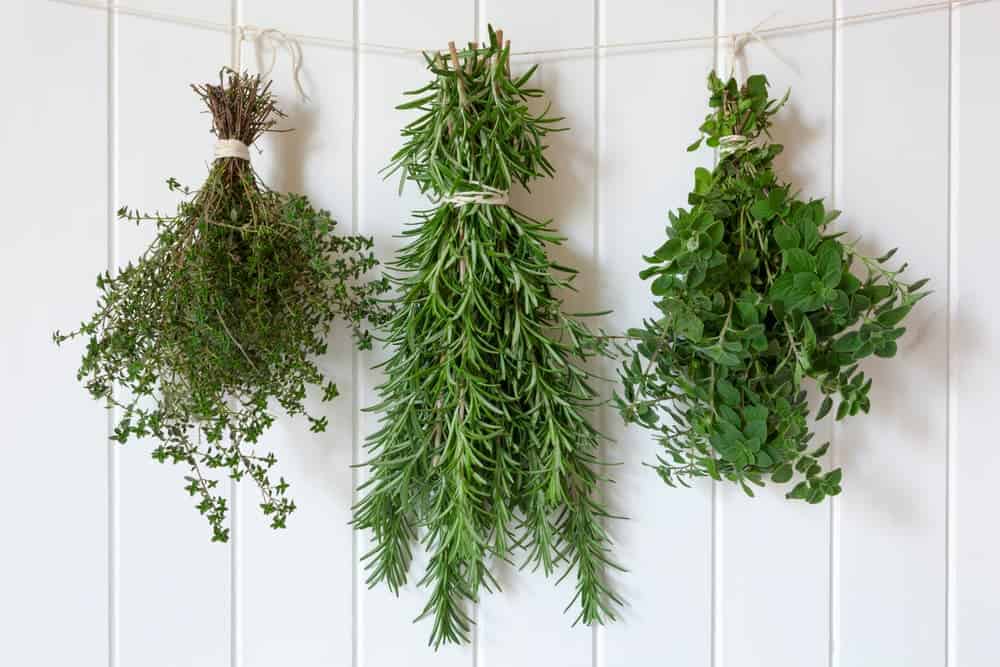A little sprinkle of fresh herbs can instantly put a delicious twist to any simple dish. The problem is they don’t stay fresh for too long. Whether they’re store-bought or homegrown, these flavourful leaves will wilt in just a few days in the fridge. Good thing I know just what you need to extend their shelf life. Try these storage methods the next time you store fresh herbs, so you can reduce food waste and save money, too!
Why Do Fresh Herbs Go Bad Easily?
Before learning how to store fresh herbs, you must first understand why they quickly wilt and rot in the first place. Keep these factors in mind when creating your delicate herbs’ ideal storage environment:
- Moisture. Excess moisture, like the ones left inside its grocery packaging, can turn your herb leaves into a pack of green slime. On the other hand, the lack of sufficient moisture can cause herbs to dry out and lose their fresh taste.
- Light. Have you noticed how herbs left on the benchtop turn yellow after a few days? Excessive exposure to direct sunlight can turn herbs like this due to damaged chlorophyll.
- Air. Excess oxygen or fridge air can bruise the tender stems of your herbs. Without proper storage, their leaves will wilt and turn brown, too.
- Temperature. Most herbs stay fresh longer when stored in the fridge. However, some varieties bruise faster or freeze in cold storage.
How to Clean Fresh Herbs Properly
Proper storage of herbs is not only dependent on these factors, though. You also need to know how to wash and dry them. Some say washing your herbs before storage will only add extra moisture. However, unwashed herbs can also carry dirt and germs that cause decay. So, for food safety and longer shelf life, wash them in cold water after purchase or harvest. Here are a few more useful herb-cleaning tips:
- Use a water-filled bowl for washing. Rather than cleaning your herbs under the tap, swishing them in a bowl of water prevents leaf or stem damage.
- Use paper towels for drying. A salad spinner can bruise or cut soft herb leaves. So, shake off excess water then lay the washed herbs on paper towels instead. Gently pat the top with more paper towels to dry. A little moisture left should protect the herbs from drying out.
How to Store Fresh Herbs in the Fridge
Fridge storage of herbs depends on whether they are soft or hard. Soft varieties, like basil, cilantro, dill, mint, parsley and tarragon, have tender stems and leaves. Hard or woody herbs, on the other hand, have sturdier stems. Examples are chives, oregano, rosemary, sage and thyme. Here’s how to store herbs in the fridge based on their category.
Soft herbs
- Trim the stem bases of your soft or tender herbs after washing and remove wilted leaves.
- Fill a mason jar or water glass with an inch of water then place herbs inside, as if they’re flowers.
- Cover the top loosely with a plastic bag before refrigerating.
- This technique should keep most tender herbs fresh for 2 to 3 weeks.
Hard herbs
- After washing and patting your hardy herbs dry, lay them lengthwise on slightly damp paper towels.
- Roll the hard herbs loosely then slip the bundle into a resealable plastic bag with some air holes.
- This technique should keep most hard herbs fresh in the fridge for 1 to 2 weeks.
Fridge storage notes
- Fresh basil is a bit more sensitive in the cold. So, you may want to leave its water-filled jar uncovered at room temperature instead, on a sunny benchtop. It should stay fresh there for a few days. Make sure to change the water as needed. Try this method for tarragon, parsley, oregano, cilantro and mint, too.
- Alternatively, you can chop fresh basil, chives or mint to save on prep time, put them in ramekins, cover with a damp paper towel then refrigerate. The chopped herbs should last for three days or more (when covered with plastic wrap).

How to Store Fresh Herbs in the Freezer
If you have a thriving herb garden at home, chances are you have far too many fresh herbs to fit and last inside the fridge. In this case, freezing herbs is the next best solution. Herbs that are best for freezer storage are basil, chives, dill, lemongrass, mint, oregano, sage, tarragon and thyme. Just make sure to keep your freezer at the proper temperature (-18C). Here are some freezer storage methods you can try:
- Baking tray method. Place your cleaned whole herbs in a single layer on a baking sheet, then freeze them for an hour or so. Slip the frozen herbs inside freezer bags or plastic containers, and store them in the freezer for up to 2 months. This technique is best for hard herbs.
- Ice cube tray method. For soft herbs, you can remove the individual leaves from the stems, chop them up then transfer them into each ice cube compartment. Ideally, portion them into teaspoons or tablespoons so you can easily add them to your recipes. Fill each tray section with water then freeze for 2 hours. Pop the herb cubes out and transfer into plastic freezer bags. Use them within six months.
- Olive oil method. Blitz herbs like basil parsley, thyme, oregano or sage in a food processor. While blending, drizzle olive oil to coat the chopped herbs (ideal ratio is 3 tbsp of herbs to 1 tbsp of olive oil). Transfer the mixture into single-serve freezer bags then freeze up to 4 months. You can also blitz the herbs with aromatics like garlic, ginger or fennel if you like.
Freezer storage notes
- Use freezer-safe containers for your herbs. Also, label them properly with the date and apply the first-in, first-out system.
- You don’t need to thaw out frozen herbs before use. You can directly add them to your hot soups or roast and cold beverages or cocktails.
How to Dry Herbs for Storage
Drying is yet another technique for preserving fresh herbs. And there are also several methods on how to do it:
- Air drying. This one is ideal for low-moisture herbs like bay leaves, dill, marjoram, rosemary, oregano and thyme. You can air-dry herbs by tying them in bundles using a rubber band then hanging them. The herbs should be dry in a week or two, at times longer for more humid areas. You can also pluck individual leaves then lay them flat on a cheesecloth or drying screen to dry. To test if they are dry enough, place a few leaves on your palm then crush them with your fingers. If they break up to pieces easily, your dried herbs are ready for storage.
- Oven drying. Preheat the oven at the lowest setting (around 75C to 82C). Lay your herbs on a baking tray lined with a silicone mat then slide it in (middle rack). Leave the oven door slightly propped open then bake the fresh herbs for about 30 minutes. Check or rotate the tray every 15 minutes then do the crumble test to see if they’re dry enough.
- Dehydrating. If you have a food dehydrator, it can dry your herbs in 2 to 4 hours. This method is best for succulent herbs like mint, basil, chives and tarragon.
Dry storage notes
- Some may suggest using the microwave oven for drying herbs. A downside of this method, though, is that it tends to cook the herb, resulting in flavour loss.
- Store your dried herbs in glass jars or airtight containers, in a cool, dark place.
- Use your dried herbs within 4 to 6 months.


